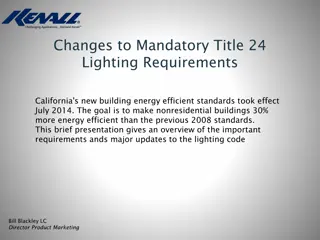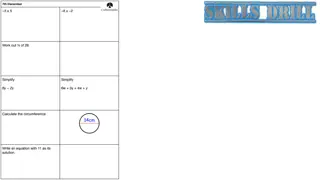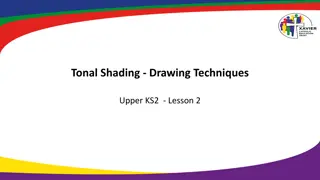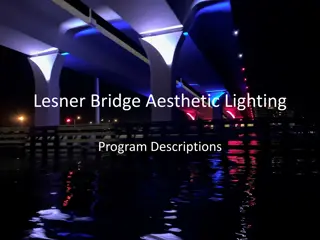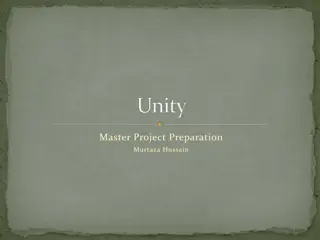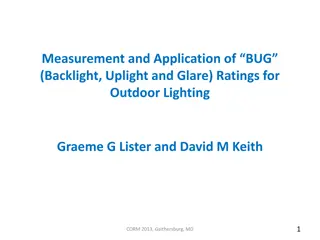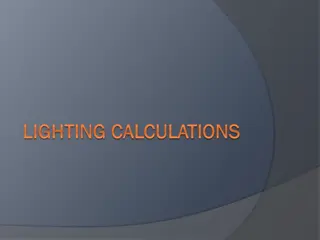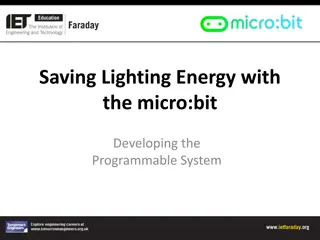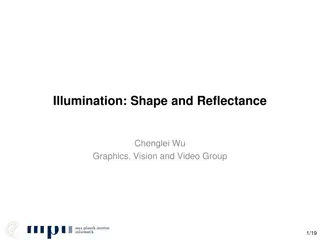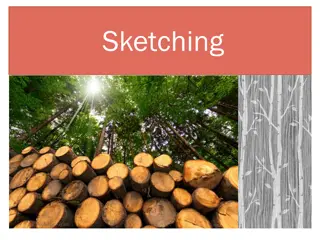Understanding OpenGL Shading and Lighting Techniques
Explore the world of OpenGL shading and lighting through lectures on computer graphics. Delve into methodologies, demo examples, importance of lighting, color primers, and shading techniques like Gouraud and Phong. Gain insights into vertex and fragment shaders, different types of lighting, and materials. Get ready to dive into HW2 with a solid understanding of shading and lighting concepts.
Download Presentation

Please find below an Image/Link to download the presentation.
The content on the website is provided AS IS for your information and personal use only. It may not be sold, licensed, or shared on other websites without obtaining consent from the author. Download presentation by click this link. If you encounter any issues during the download, it is possible that the publisher has removed the file from their server.
E N D
Presentation Transcript
Computer Graphics CSE 167 [Win 19], Lecture 7: OpenGL Shading Ravi Ramamoorthi http://viscomp.ucsd.edu/classes/cse167/wi19
To Do This week s lectures have all info for HW 2 Start EARLY (milestone due Monday Feb 4)
Methodology for Lecture Lecture deals with lighting (DEMO for HW 2) Briefly explain shaders used for mytest3 Do this before explaining code fully so you can start HW 2 Primarily explain with reference to source code More formal look at lighting and shading possible Will be discussed in more detail if you take CSE 163
Demo for mytest3 Lighting on teapot Blue, red highlights Diffuse shading Texture on floor Update as we move
Importance of Lighting Important to bring out 3D appearance (compare teapot now to in previous demo) Important for correct shading under lights The way shading is done also important Flat: Entire face has single color (normal) from one vertex Gouraud or smooth: Colors at each vertex, interpolate glShadeModel(GL_FLAT) [old] glShadeModel(GL_SMOOTH) [old]
Brief primer on Color Red, Green, Blue primary colors Can be thought of as vertices of a color cube R+G = Yellow, B+G = Cyan, B+R = Magenta, R+G+B = White Each color channel (R,G,B) treated separately RGBA 32 bit mode (8 bits per channel) often used A is for alpha for transparency if you need it Colors normalized to 0 to 1 range in OpenGL Often represented as 0 to 255 in terms of pixel intensities Also, color index mode (not so important)
Outline Gouraud and Phong shading (vertex vs fragment) Types of lighting, materials and shading Lights: Point and Directional Shading: Ambient, Diffuse, Emissive, Specular Fragment shader for mytest3 HW 2 requires a more general version of this Source code in display routine
Vertex vs Fragment Shaders Can use vertex or fragment shaders for lighting Vertex computations interpolated by rasterizing Gouraud (smooth) shading, as in mytest1 Flat shading: no interpolation (single color of polygon) Either compute colors at vertices, interpolate This is standard in old-style OpenGL Can be implemented with vertex shaders Or interpolate normals etc. at vertices And then shade at each pixel in fragment shader Phong shading (different from Phong illumination) More accurate Wireframe: glPolygonMode (GL_FRONT, GL_LINE) Also, polygon offsets to superimpose wireframe Hidden line elimination? (polygons in black )
Gouraud Shading Details Ia=I1(ys- y2)+I2(y1- ys) y1- y2 Ib=I1(ys- y3)+I3(y1- ys) y1- y3 Ip=Ia(xb- xp)+Ib(xp- xa) xb- xa I1 y1 Ia Ib Ip Scan line ys y2 I2 y3 I3 Actual implementation efficient: difference equations while scan converting
Gouraud and Errors I1 = 0 because (N dot E) is negative. I2 = 0 because (N dot L) is negative. Any interpolation of I1 and I2 will be 0. I1 = 0 I2 = 0 area of desired highlight
Phong Illumination Model Specular or glossy materials: highlights Polished floors, glossy paint, whiteboards For plastics highlight is color of light source (not object) For metals, highlight depends on surface color Really, (blurred) reflections of light source Roughness
2 Phongs make a Highlight Besides the Phong Illumination or Reflectance model, there is a Phong Shading model. Phong Shading: Instead of interpolating the intensities between vertices, interpolate the normals. The entire lighting calculation is performed for each pixel, based on the interpolated normal. (Old OpenGL doesn t do this, but you can and will with current fragment shaders) I1 = 0 I2 = 0
Examples and Color Plates See OpenGL color plates (earlier eds) and glsl book http://blog.cryos.net/categories/15-Avogadro/P3.html http://blenderartists.org/forum/showthread.php?11430-Games-amp-Tutorials-(updated-Jan-5-2011)
Simple Vertex Shader in mytest3 #version 330 core // Do not use any version older than 330! // Inputs layout (location = 0) in vec3 position; layout (location = 1) in vec3 normal; layout (location = 2) in vec2 texCoords; // Extra outputs, if any out vec4 myvertex; out vec3 mynormal; out vec2 texcoord; // Uniform variables uniform mat4 projection; uniform mat4 modelview; uniform int istex ;
Simple Vertex Shader in mytest3 void main() { gl_Position = projection * modelview * vec4(position, 1.0f); mynormal = mat3(transpose(inverse(modelview))) * normal ; myvertex = modelview * vec4(position, 1.0f) ; texcoord = vec2 (0.0, 0.0); // Default value just to prevent errors if (istex != 0){ texcoord = texCoords; } }
Outline Gouraud and Phong shading (vertex vs fragment) Types of lighting, materials and shading Lights: Point and Directional Shading: Ambient, Diffuse, Emissive, Specular Fragment shader for mytest3 HW 2 requires a more general version of this Source code in display routine
Lighting and Shading Rest of this lecture considers lighting In real world, complex lighting, materials interact We study this more formally in CSE 163 For now some basic approximations to capture key effects in lighting and shading Inspired by old OpenGL fixed function pipeline But remember that s not physically based
Types of Light Sources Point Position, Color Attenuation (quadratic model) 1 atten = kc+kld +kqd2 Attenuation Usually assume no attenuation (not physically correct) Quadratic inverse square falloff for point sources Linear falloff for line sources (tube lights). Why? No falloff for distant (directional) sources. Why? Directional (w=0, infinite far away, no attenuation) Spotlights (not considered in homework) Spot exponent Spot cutoff
Material Properties Need normals (to calculate how much diffuse, specular, find reflected direction and so on) Usually specify at each vertex, interpolate GLUT used to do it automatically for teapots etc (we provide meshes with normals instead for you in hw 2) Can do manually for parametric surfaces Average face normals for more complex shapes Four terms: Ambient, Diffuse, Specular, Emissive
Emissive Term I = Emissionmaterial Only relevant for light sources when looking directly at them Gotcha: must create geometry to actually see light Emission does not in itself affect other lighting calculations
Ambient Term Hack to simulate multiple bounces, scattering of light Assume light equally from all directions Global constant Never have black pixels I = Ambient
Diffuse Term Rough matte (technically Lambertian) surfaces Light reflects equally in all directions N -L
Diffuse Term Rough matte (technically Lambertian) surfaces Light reflects equally in all directions N -L n I = *diffusematerial*atteni*[max (LiN,0)] intensitylight i i=0
Specular Term Glossy objects, specular reflections Light reflects close to mirror direction
Phong Illumination Model Specular or glossy materials: highlights Polished floors, glossy paint, whiteboards For plastics highlight is color of light source (not object) For metals, highlight depends on surface color Really, (blurred) reflections of light source Roughness
Idea of Phong Illumination Find a simple way to create highlights that are view- dependent and happen at about the right place Not physically based Use dot product (cosine) of eye and reflection of light direction about surface normal Alternatively, dot product of half angle and normal Has greater physical backing. We use this form Raise cosine lobe to some power to control sharpness or roughness
Phong Formula R -L E R = -L+2(LiN)N R = ?
Alternative: Half-Angle (Blinn-Phong) H N n I = *specularmaterial*atteni*[max (N H,0)]shininess intensitylight i i=0 Diffuse and specular components for most materials
Demo in mytest3 What happens when we make surface less shiny?
Outline Gouraud and Phong shading (vertex vs fragment) Types of lighting, materials and shading Lights: Point and Directional Shading: Ambient, Diffuse, Emissive, Specular Fragment shader for mytest3 HW 2 requires a more general version of this Source code in display routine
Fragment Shader Setup #version 330 core // Do not use any version older than 330! // Inputs fragment shader are outputs of same name of vertex shader in vec4 myvertex; in vec3 mynormal; in vec2 texcoord; // Output the frag color out vec4 fragColor; uniform sampler2D tex ; uniform int istex ; uniform int islight ; // are we lighting. uniform vec3 color;
Fragment Shader Variables // Assume light 0 is directional, light 1 is a point light. // Actual light values are passed from the main OpenGL program. // This could be fancier. My goal is to illustrate a simple idea. uniform vec3 light0dirn ; uniform vec4 light0color ; uniform vec4 light1posn ; uniform vec4 light1color ; // Now, set the material parameters. These could be bound to // a buffer. But for now, I'll just make them uniform. // I use ambient, diffuse, specular, shininess. // Ambient is just additive and doesn't multiply the lights. uniform vec4 ambient ; uniform vec4 diffuse ; uniform vec4 specular ; uniform float shininess ;
Fragment Shader Compute Lighting vec4 ComputeLight (const in vec3 direction, const in vec4 lightcolor, const in vec3 normal, const in vec3 halfvec, const in vec4 mydiffuse, const in vec4 myspecular, const in float myshininess) { float nDotL = dot(normal, direction) ; vec4 lambert = mydiffuse * lightcolor * max (nDotL, 0.0) ; float nDotH = dot(normal, halfvec) ; vec4 phong = myspecular * lightcolor * pow (max(nDotH, 0.0), myshininess) ; vec4 retval = lambert + phong ; return retval ; }
Fragment Shader Main Transforms void main (void) { if (istex > 0) fragColor = texture(tex, texcoord); else if (islight == 0) fragColor = vec4(color, 1.0f) ; else { // They eye is always at (0,0,0) looking down -z axis // Also compute current fragment position, direction to eye const vec3 eyepos = vec3(0,0,0) ; vec3 mypos = myvertex.xyz / myvertex.w ; // Dehomogenize vec3 eyedirn = normalize(eyepos - mypos) ; // Compute normal, needed for shading. vec3 normal = normalize(mynormal) ;
Fragment Shader Main Routine // Light 0, directional vec3 direction0 = normalize (light0dirn) ; vec3 half0 = normalize (direction0 + eyedirn) ; vec4 col0 = ComputeLight(direction0, light0color, normal, half0, diffuse, specular, shininess) ; // Light 1, point vec3 position = light1posn.xyz / light1posn.w ; vec3 direction1 = normalize (position - mypos) ; // no attenuation vec3 half1 = normalize (direction1 + eyedirn) ; vec4 col1 = ComputeLight(direction1, light1color, normal, half1, diffuse, specular, shininess) ; fragColor = ambient + col0 + col1 ; } }
Outline Gouraud and Phong shading (vertex vs fragment) Types of lighting, materials and shading Lights: Point and Directional Shading: Ambient, Diffuse, Emissive, Specular Fragment shader for mytest3 HW 2 requires a more general version of this Source code in display routine
Light Set Up (in display) /* New for Demo 3; add lighting effects */ { const GLfloat one[] = {1,1,1,1} ; const GLfloat medium[] = {0.5f, 0.5f, 0.5f, 1}; const GLfloat small[] = {0.2f, 0.2f, 0.2f, 1}; const GLfloat high[] = {100} ; const GLfloat zero[] = {0.0, 0.0, 0.0, 1.0} ; const GLfloat light_specular[] = {1, 0.5, 0, 1}; const GLfloat light_specular1[] = {0, 0.5, 1, 1}; const GLfloat light_direction[] = {0.5, 0, 0, 0}; // Dir lt const GLfloat light_position1[] = {0, -0.5, 0, 1}; GLfloat light0[4], light1[4] ; // Set Light and Material properties for the teapot // Lights are transformed by current modelview matrix. // The shader can't do this globally. So we do so manually. transformvec(light_direction, light0) ; transformvec(light_position1, light1) ;
Moving a Light Source Lights transform like other geometry Only modelview matrix (not projection). The only real application where the distinction is important Types of light motion Stationary: set the transforms to identity before specifying it Moving light: Push Matrix, move light, Pop Matrix Moving light source with viewpoint (attached to camera). Can simply set light to 0 0 0 so origin wrt eye coords (make modelview matrix identity before doing this)
Modelview Light Transform /* New helper transformation function to transform vector by modelview */ void transformvec (const GLfloat input[4], GLfloat output[4]) { glm::vec4 inputvec(input[0], input[1], input[2], input[3]); glm::vec4 outputvec = modelview * inputvec; output[0] = outputvec[0]; output[1] = outputvec[1]; output[2] = outputvec[2]; output[3] = outputvec[3]; }
Set up Lighting for Teapot glUniform3fv(light0dirn, 1, light0) ; glUniform4fv(light0color, 1, light_specular) ; glUniform4fv(light1posn, 1, light1) ; glUniform4fv(light1color, 1, light_specular1) ; // glUniform4fv(light1color, 1, zero) ; glUniform4fv(ambient,1,small) ; glUniform4fv(diffuse,1,medium) ; glUniform4fv(specular,1,one) ; glUniform1fv(shininess,1,high) ; // Enable and Disable everything around the teapot // Generally, we would also need to define normals etc. // But the teapot object file already defines these for us. if (DEMO > 4) glUniform1i(islight,lighting) ; // lighting only teapot.
Shader Mappings in init vertexshader = initshaders(GL_VERTEX_SHADER, "shaders/light.vert") ; fragmentshader = initshaders(GL_FRAGMENT_SHADER, "shaders/light.frag") ; shaderprogram = initprogram(vertexshader, fragmentshader) ; // * NEW * Set up the shader parameter mappings properly for lighting. islight = glGetUniformLocation(shaderprogram,"islight") ; light0dirn = glGetUniformLocation(shaderprogram,"light0dirn") ; light0color = glGetUniformLocation(shaderprogram,"light0color") ; light1posn = glGetUniformLocation(shaderprogram,"light1posn") ; light1color = glGetUniformLocation(shaderprogram,"light1color") ; ambient = glGetUniformLocation(shaderprogram,"ambient") ; diffuse = glGetUniformLocation(shaderprogram,"diffuse") ; specular = glGetUniformLocation(shaderprogram,"specular") ; shininess = glGetUniformLocation(shaderprogram,"shininess") ;
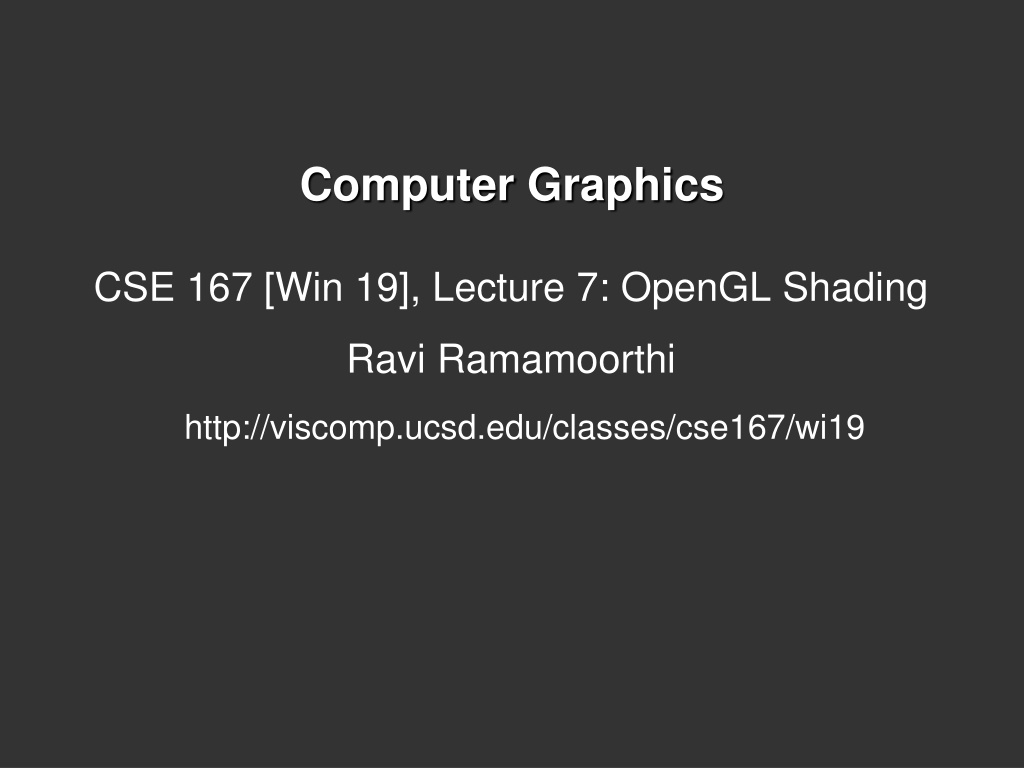
 undefined
undefined


